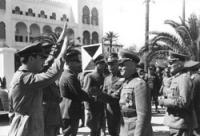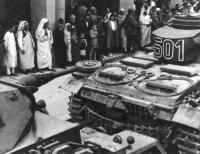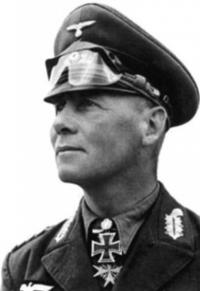
Italian General Italo Gariboldi (l) welcoming German General Rommel, Tripoli, February 12, 1941.

German Armor of the the Fifth Light Division parade throught Tripoli upon arrival.

Rommel with captured dust goggles.
This month, seventy years ago, a slight, unassuming man, in German uniform, stepped out of a German airplane onto the tarmac of Castel Benito airfield at Tripoli, Libya. Only a few knew his identity. He was Lieutenant General Erwin Rommel. His last command had been of the Seventh Armored Division in the brief campaign in France. Under his leadership the Seventh had moved so quickly that it came to be known as the “Ghost Division” because no one knew its location. General Rommel had yet to acquire much of an international reputation. All that was about to change. His Führer had tasked him with a very difficult job.
By now, the Italian Armed Forces were dispirited and demoralized. In November the Royal Navy had struck a devastating blow against Regia Marina Italia at its base in Taranto. This was followed, the following month, by a humiliating defeat by numerically inferior Commonwealth troops, which resulted in the surrender of 130,000 Italian soldiers in the North African desert and the loss of the eastern Libyan province of Cyrenaica. The abysmal showing of the Regia Escercito Italia against the Kingdom of Greece added to the Italian plight. The Greeks had recovered all of the territory that the Italians had initially occupied, and then some. Reluctantly, the Italian Duce had had to ask the German Führer for assistance in both theaters.
Before he was to leave the African continent, the German general’s name would be known far and wide, by enemies and friends, and he would acquire the sobriquet, Der Wustenfuchs - “The Desert Fox.” Hitler selected Rommel, in part, because he had had such great success against the Italians during The Great War, serving with distinction in the Alpen Korps and winning Germany’s highest honor for bravery - the Pour le Mérite or “Blue Max” - against the Italians. It was just a little acid that the German leader poured into the Italian wound.
The Germans understood the importance of assisting their Italian Ally. The benefits of the continued Italian participation in the War were numerous: (1) the Regia Marina Italia occupied a considerable portion of the Royal Navy; (2) having the Italians stand with them was an enormous psychological boost for the German people - it was very important for them to know that they were not alone in the struggle; (3) although the Regia Aeronautica was not as crisp and as efficient as the Luftwaffe, it still made significant contributions. And even though General Rommel would, in effect, be running the show in North Africa, the Italians would still shoulder the major burdens and would theoretically be in command.They would be responsible for transporting supplies from Italy to North Africa, and off-loading the ships. In addition, their numerical contribution would always be greater than the Germans. The contributions of the Regia Aeronautica in helping to neutralize Malta and providing air cover for the convoys from Italy to Libya were crucial. And, of course, the naval escorts for the convoys were provided by the Regia Marina Italia.
But when Rommel arrived, all this was in the future. The Italians in the Libyan colony’s capital of Tripoli were not awaiting his arrival, but rather the arrival of enemy troops. Unbeknownst to them, just as that was about to occur, British Prime Minister Churchill stripped the attackers of their best troops and sent them to other theaters, such as East Africa and Greece. By the time Rommel arrived, the threat was virtually nonexistent.
General Rommel had been ordered to appear at Oberkomando Heere (OKH) on February 6, 1941. There he met with Army Chief, Field Marshal Walther Brauchitsch, who briefed him on his new command. That afternoon, he met with the der Führer himself. The two were well acquainted, as Rommel had served as commander of Hitler’s field headquarters during the Polish Campaign, as well as during the occupation of the Sudetenland. It was impressed upon him, that he was being sent to Africa, to ensure that the Italians didn’t lose Libya, and get out of the war. He was not there to mount any great offensive. Grand Admiral Erich Raeder, commander of the Kriegsmarine, felt that the Germans ought to go all in, take Malta, Gibralter, and Egypt, eliminating the Royal Navy from the Mediterranean and thereby freeing the Regia Marina Italia to assist in the blockade of Great Britain. But der Führer was fixated with the Soviet Union, and making the same mistake as the great Napoléon.
Following a few more days of orientation with the General Staff regarding Operation Sonnenblume (Sunflower), Rommel flew to Rome where he met with General Alfredo Guzzoni, Deputy Chief of Commando Supremo on the morning of February 11, 1941. Later that day, he flew to Sicily, where he met with General Hans-Ferdinand Geissler, commander of the Luftwaffe’s Fliegerkorps X, recently relocated from Norway to Sicily. Gen. Geissler wanted to bomb the Libyan port of Benghazi, which had been captured by Commonwealth forces the prior week. However, the Italians would not permit it because many Italian officers owned homes there. Through Rommel’s connections with Hitler, that issue was quickly resolved. The next day the Luftwaffe attacked Benghazi.
General Rommel flew to Tripoli that same day. At 1:00 P.M., he reported to his nominal superior, Italo Gariboldi. General Gariboldi, who had previously commanded the Italian Fifth Army, had just been appointed the commander of all Italian forces in Libya and would be named to replace Marshal Rodolfo Graziani (who, having asked to be relieved, left Libya the day before) as Governor-General on March 25, 1941. Following his meeting with the Italian general, Rommel conducted his own reconnaissance from the air. Upon his return, he again reported to Gen. Gariboldi, and convinced him to move some of the Italian troops further east, towards the enemy, to the village of Sirte-Buerat.
Two days later, the first German troops arrived - 3rd Reconnaissance Battalion of the 5th Light Division. As soon as they disembarked, they paraded through the streets of Tripoli - several times, to give the impression of greater numbers. An Italian observer marveled at the efficiency with which the Germans disembarked and off-loaded their equipment. He noted that the Germans did it in a few hours, whereas his countrymen would have required three days and then another ten to find everything again and get organized!
Within two days of its arrival, the 3rd Reconnaissance Battalion was also moving east - 360 miles - by the Via Balbia. It established camp near Sirte and scared off some Commonwealth reconnaissance units near El Nofilia. The next day, the Germans advanced another 100 miles east to the Arco dei Fileni, and established the division headquarters there. The Arco had been built by Mussolini and marked the border between the western Libyan province of Tripolitania and the eastern province of Cyrenaica. Upon the ascendancy of the Quadaffi regime, in 1970, it was destroyed.
On February 19, Hitler suggested that the German contingent be called the Deutsches Afrika Korps (DAK). Later the 5th Light would be changed to the 21st Panzer. In the meantime, the elite Italian Ariete Armored Division, commanded by General Ettore Baldassare, was also arriving. Already present were the Brescia, Bologna and Pavia Motorized Infantry Divisions, and the Savona and Sabratha Infantry Divisions, commanded by, respectively, Giacomo Lombardi, Alessandro Gloria, Pietro Zaglio, Fedele de Giorgis, and Mario Soldarelli. The term “motorized” was more theoretical than real.
The first contact between the Deutsches Afrika Korps and Commonwealth forces occurred when an armoured car of the King’s Dragoon Guards was captured on February 24.
The first German “88s” arrived on March 2, 1941. This was the most famous piece of artillery in the war. It was originally designed as an ant-aircraft gun, but during the Spanish Civil War, the Germans discovered that it was a fabulous antitank gun as well. Rommel had used them to stop the British offensive at the Battle of Arras, and would use them to great effect against British armor in North Africa. As one captured British officer noted, “It doesn’t look so hot, but nothing can be done against it. It will prove the undoing of the Matilda.” That same day, British General Sir Archibald Wavell opined that, “I do not think that with this force he will attempt to recover Benghazi.”
On March 11, the Panzer regiment of the 5th Light Division, consisting of 120 tanks arrived in Tripoli. After the obligatory parade in Tripoli, they were immediately sent east. Two days later, General Rommel moved his headquarters east to Sirte, and convinced General Gariboldi to send the Ariete Armored Division and the Brescia Motorized Infantry Division to join him. On March 15, Rommel sent a force of Italians, south, across the desert, to occupy Murzuch.
The General flew to Berlin, on March 19, where he was awarded the Oak Leaves to his Knight’s Cross and ordered not to begin offensive operations until the arrival of 15th Panzer Division, in May. Upon his return to Libya, 3rd Reconnaissance Battalion, led by Lt. Col. Irmfried von Wechmar, occupied El Agheila, on March 24, as Commonwealth forces withdrew to Mersa el Brega. Churchill sent a message to General Wavell, asking if Wavell was, “...planning to let the tortoise stick his neck out far enough before chopping it off?” On March 30, Mersa el Brega was assaulted, with General Rommel leading from the front, and the next day, recaptured.
After Agedabia and the port of Zuetina were recaptured, together with 800 prisoners, on April 2, General Gariboldi, as he had done after El Agheila was taken, and again after Mersa el Brega was recaptured, ordered the German General to halt. The Italian General sent the following message: “From information I have received, I deduce that your advance continues. This is contrary to my orders. I ask you to wait for me before continuing the advance.”
But Rommel, who was at the front, and could see the Commonwealth troops withdrawing in disarray, “...decided to stay on the heels of the retreating enemy and make a bid to seize the whole of Cyrenaica at one stroke.” To that end he decided to mount a three-pronged assault that day. Lt.Col. von Wechmar would lead his 3rd Reconnaissance Battalion, together with the Italian Brescia Motorized Division, in pursuit of the retreating enemy along the coast to Benghazi.
Meanwhile, in an effort to intercept the retreating Commonwealth forces, as the Commonwealth forces had done to the Italians two months prior, part of the Light Division and a reconnaissance battalion from the Ariete Division crossed the desert through Ben Gania and Bir Tengedir to the coast at Derna to block the enemy’s escape route. At the same time, a third force, consisting of the tanks of the 5th Panzer Regiment, commanded by Col. Olbrich, the rest of the Ariete Division, and two Bersaglieri Motorized Battalions of the Pavia Division, headed into the desert through Msus to Fort Mechili, between the two other columns.
When the commanders of these last two forces complained of the impassability of the harsh terrain, General Rommel dismissed them, saying, “The desert tracks are passable. I myself have flown over them!” As these troops were making their way across the desert, Gen. Rommel rode herd on them from the air. If he saw a unit that wasn’t moving, he would drop a note saying, “If you don’t start moving, I shall come down! Rommel”
Commonwealth forces were disadvantaged by something which should have been, and usually was, an advantage - “Ultra.” “Ultra” was the codename for the British project which broke the German Enigma codes. The British knew that General Rommel had been ordered to abstain from any offensive action, and so were not expecting any and were taken unawares when the German General disobeyed orders and launched a major offensive, dislodging the Allies from the eastern part of Libya.
Benghazi was abandoned by Commonwealth troops on April 3 and occupied by Axis troops the next morning. On April 7, Derna was retaken, together with 1000 prisoners.
On April 6, Italian armor of the Ariete Division and the two Bersaglieri battalions began to reach Fort Mechili. The Bersaglieri were elite Italian soldiers. The defenders were British, Australian and Indian soldiers. Two days later, Maj. Gen. Michael D. Gambier-Parry, commander British 2nd Armored Division, surrendered Fort Mechili to Col. Ugo Montemurro, commander of one of the Bersaglieri battalions, together with another 3000 prisoners, and enough supplies and fuel to allow the Axis advance to continue. Also among those captured was Brigadier General Edward William Drummond Vaughan, commander of the Third Indian Motor Brigade. For this, General Rommel personally pinned the Iron Cross, Second Class, to the chest of the Italian Colonel. He was the first Italian to be awarded the Iron Cross.
Rommel was able to commandeer, from the captured booty at Fort Mechili, an enormous van, which was to become his mobile headquarters, nicknamed Mamout, or “Mammoth” in English, and which became ever-present at the front. It was described by German war correspondent Fritz Lucke as, “...an armored box as big as a bus, on giant balloon tires as big and fat as the undercarriage wheels of a Junkers plane. The walls are windowless and painted in blue-gray camouflage tints. Only the driver and his co-driver have windshields, protected behind armored visors.” In the van, he found a pair of dust goggles that became his trademark while he was in the desert. He always wore them on his cap, between the eagle and the brim.
Meanwhile, the Brescia Division recaptured Tmimi, on the coast, after its evacuation by the enemy. Bardia was recaptured on April 13 and Sollum, on the Egyptian side of the border, two days later. But the Commonwealth forces were not destroyed, and the Aussies still held Tobruk.
Although General Rommel’s forces were unable to completely destroy the enemy forces and/or capture the important Libyan port of Tobruk, they did bag a few other prizes. On April 6, Generals Sir Richard O’Connor and Sir Philip Neame were captured near Martuba. Gen. O’Connor had led the successful offensive against the Italians that had brought Rommel to Africa. General Neame, the British Governor-General of Cyreniaca, and the only man to win an Olympic Gold Medal and earn the Victoria’s Cross, was commander of Commonwealth forces in Libya. By April 15, all of Libya - except for Tobruk - was, once again, in Axis hands and Axis forces were, once again, across the Egyptian border. Ten days latter, Fort Capuzzo was recaptured and Halfaya Pass was reoccupied.
In the next two years Rommel, and the Afrika Korps, would become world famous. He would earn the love of his soldiers - both German and Italian - and the respect and admiration of the enemy. His nemesis, British General Bernard Law Montgomery, hung an oil painting of Rommel over his desk, in his headquarters van, and named his dog for him. At one point, the British Prime Minister was driven to exclaim, “Rommel! Rommel! Rommel! What else matters but beating him?”
NEXT MONTH: THE ROYAL NAVY VS. REGIA MARINA ITALIA AT CAPE MATAPAN
Mr. Wimbrow writes from Ocean City, Maryland, where he practices law representing those persons accused of criminal and traffic offenses, and those persons who have suffered a personal injury through no fault of their own.
«Go back to the previous page.


